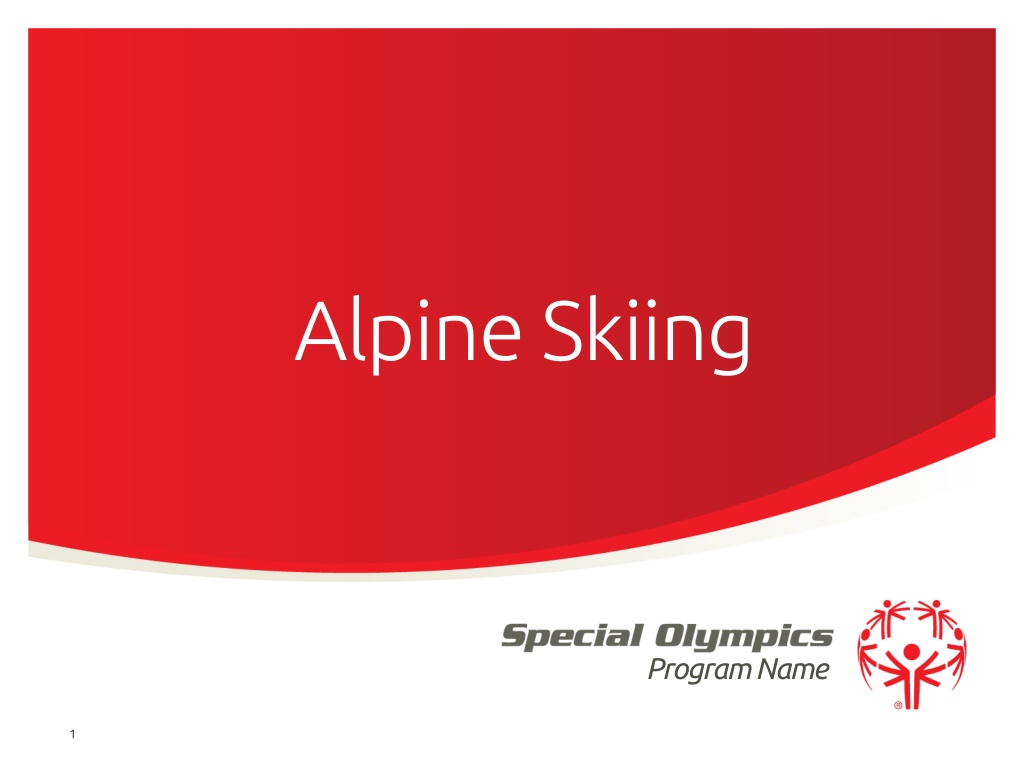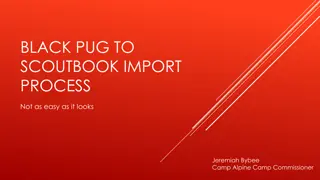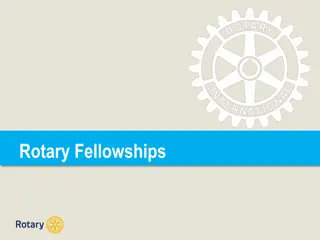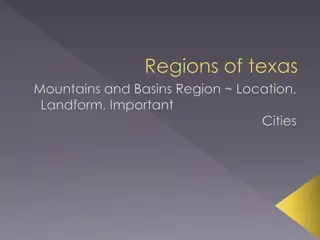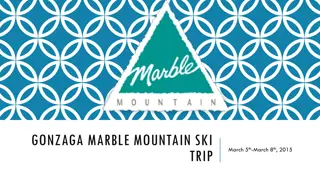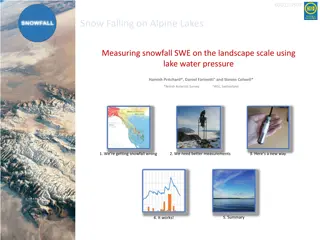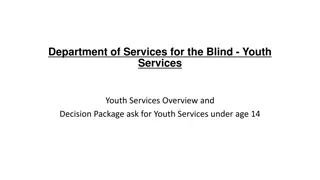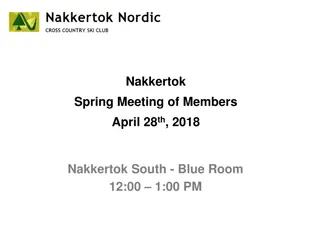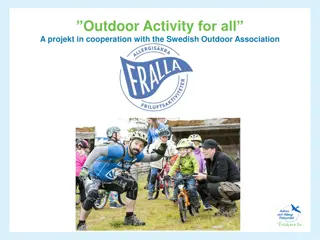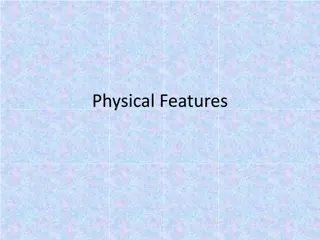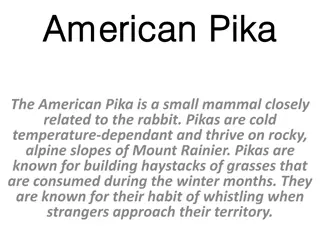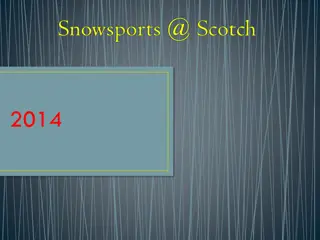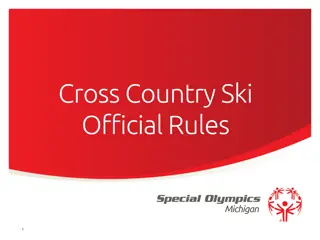Alpine Skiing Program Overview
Alpine skiing program offers various events like Slalom, Giant Slalom, and Super-G for different skill levels. Novice skiers can participate in Giant Slalom and Super-G with specific requirements, while Intermediate and Advanced skiers have more options. It's essential for athletes to meet safety guidelines, wear proper attire, and use approved equipment. The course layout includes details on setting up gates for Slalom, Giant Slalom, and Super-G events. Participants must adhere to rules to ensure fair competition at State Winter Games Alpine Skiing events.
Download Presentation

Please find below an Image/Link to download the presentation.
The content on the website is provided AS IS for your information and personal use only. It may not be sold, licensed, or shared on other websites without obtaining consent from the author.If you encounter any issues during the download, it is possible that the publisher has removed the file from their server.
You are allowed to download the files provided on this website for personal or commercial use, subject to the condition that they are used lawfully. All files are the property of their respective owners.
The content on the website is provided AS IS for your information and personal use only. It may not be sold, licensed, or shared on other websites without obtaining consent from the author.
E N D
Presentation Transcript
Alpine Skiing Program Name 1
The Basics Sport season: December- February Culminating State Events: State Winter Games Alpine Skiing
Events Offered Events Offered: Slalom: Novice, Intermediate, Advanced Giant Slalom: Novice, Intermediate, Advanced Super-G: Novice, Intermediate, Advanced Unified Giant Slalom: Intermediate Unified Slalom: Intermediate 3
Recommended Events Novice (level 1) skiers may enter the Giant Slalom or Super-G. Please register in event specific for Novice. Novices will use a tow rope. Athlete can do gliding wedge to a stop and gliding wedge turns. Intermediate (Level II) and Advanced (Level III) skiers may enter the Giant Slalom, Super- G, or Slalom. They must be trained using a chairlift. Athletes should be able to do Novice requirements, plus be able to do sliding wedge turns. Advanced (Level III) skiers may enter either Giant Slalom, Super-G, or Slalom. All Advanced skiers will ride the chairlift. Athletes can do Novice and Intermediate requirements, plus be able to parallel ski. Note: if an athlete has never been on skis or cannot walk in skis, he/she should not be entered in alpine skiing. If they do not display the skills required for the level registered they will be moved up or down to the next level. If athletes create a safety hazard on the slopes the games officials have the authority to disqualify them. Alpine Skiing
Uniform & Equipment Program Name 5
Uniform Guideline and Equipment 1.Athletes should wear appropriate winter sports attire. Warm gloves or mittens, hat, scarf, headband or ski mask, and sunglasses or goggles are recommended. 2.All competitors must wear competition bibs for all time trials and finals races. Bibs must be worn on the hill at all times throughout the games, even if the athlete is not competing at that time. 3.Competition equipment such as skis, boots, bindings and poles must pass all appropriate safety guidelines. 4.All athletes competing in all skiing events must wear ski racing helmets that meet the FIS equipment specifications. All helmets must have an approved tag in order for athletes to race. Jewelry, and denim may not be worn during competition or practice. Headwear for religious or medical reasons are acceptable but must be brought to the attention of the Games Director prior to competition. 6
Course Layout Program Name 7
Course Layout 1.Slalom - One slalom pole, the turning pole, shall be used to establish a slalom gate. A Single Pole Slalom has no outside pole except for the first and last gate. The first gate should always be red. 2.Giant Slalom and Super-G - In Giant Slalom and Super-G, two sets of two poles with a panel between, constitute a gate. For Giant Slalom, the distance from the turning pole to the outside pole across the fall line is 4 to 8 meters. The Super-G distance is no less than 8 meters. For Giant Slalom and Super-G, panels shall be used. The first gate, or sets of gates, after the start should always be red. 8
Course Layout Cont. 1.An auger or crow bar shall be made available for the course setter to set poles into the snow. 2.Adequate protection for the start and finish areas shall be provided. Fencing and/or pop fencing may be used. 3.Whenever possible, for safety reasons, the courses should be fenced off to be perceived by the skiing public as a self- contained racing venue. Additional fencing, snow fencing, and protective bagging are the responsibility of the ski area. 4.Whenever possible, electric timing equipment, with back- up system, shall be used. When this is not possible, hand held timing may be used. Gate judges shall be responsible for timing the two minutes for the Two Minute Rule . Start and finish banners shall be used. 5.Information boards: Start Order Board - Shall be located at the start and contain the skiers start order, bib number, and other pertinent information. Result Board - Shall be located outside the finish area to post results and list skiers by name, start order, and bib number. General Information Board - Shall be located in close proximity to the racing venues, awards area, and lodge and contain general information and announcements. 10
General Rules Program Name 13
General Rules 1. conditions prior to attending Winter Games. It is mandatory for all athletes to be on snow regardless of snow 2. sport. Each athlete may participate in two events within the chosen sport. Special attention should be directed to recommended events for the athlete s ability level. An athlete can be registered only within one level. For example, an athlete cannot be in Novice Slalom and Intermediate Super-G. Each athlete participating at the Games may only compete in one 3. safety reasons. If athletes are found on the hill unsupervised or if they are a safety hazard to others, they will be escorted off the hill. All athletes must be accompanied by an Intermediate ski coach for 4. Coaches MAY NOT coach on the hill. 14
General Rules Cont. 5. they cross the finish line. Example: Two skies and one pole. A skier must have three (3) pieces of equipment on them when 6. must have an x-ray prior to participation indicating that they don t have atlantoaxial instability. Athletes with Down Syndrome who may compete in Alpine Skiing 7. Start Areas I. in either a relaxed or ready position. Care should be given to provide easy access to this area as well as securing the area from the flow of general public skier traffic. All start areas shall be flat, enabling the skiers to stand in the start 15
General Rules Cont. 8. One Minute Rule I. of the line of the course (fall, miss a gate, lose a ski, etc.) he/she shall have 1 minute from the time of the deviation to re-enter the course. During competition, if the competitor moves out of the general direction II. assistance of any kind, shall be disqualified. Disqualification shall be determined on the gate card by the Gate Judge assigned to the gate closest to where the infraction occurred. A competitor who fails to adhere to this 1-minute time limit, or receives III. The Gate Judge is responsible for timing the 1 minute. 9. Start command I. command shall be as follows: "5.4.3.2.1. GO!" The timer begins when the skier s front boot crosses the start line, or when the electric timing wand is activated. For all Special Olympics alpine events at each ability level, the start 16
General Rules Cont. 3. Gate Line I. pairs of poles holding panels between them, is the imaginary shortest line between the two inner poles at ground (snow) level. The gate line in the slalom is the imaginary shortest line between the turning pole and the outside pole at ground (snow) level. The gate line in downhill and giant slalom, where a gate consists of two 4. Correct Passage I. both feet have passed across the gate line. A gate has been passed correctly when both the competitors ski tips and II. slalom pole), then the tip of the remaining ski and both feet must have passed the gate line. If a competitor loses a ski without committing a fault (not by straddling a III. The start and finish lines are the same as a gate line. IV. before both the competitors ski tips and both feet have passed the gate line, the ski tips and feet must pass the original gate line (marking in the snow). In the event that a competitor removes a pole from its vertical position 17
General Rules Cont. 5. Divisioning I. Special Olympics Winter Sports Rules for clarifications of divisioning. All coaches are reminded to review the sections in the Official II. modified giant slalom course of their ability level, with the fastest time used to determine their division for competition. If there is time, divisioning time trials may be conducted for each event. Novice, intermediate and advanced skiers shall have two runs on a III. starts first, the slowest last. In the first run of competition in each division, the fastest time IV. the games officials have the authority to move the athlete to their correct level. If an athlete does not perform at the level they are registered for V. If an athlete performs in an unsafe manner they will be disqualified 18
Event Modifications Program Name 19
Event Modifications 1.Slalom/Giant Slalom: I. Slalom and Giant Slalom races will consist of two timed runs. The combined times for each discipline will determine the results for awards. II. A course reset for the second run will be determined by the Jury. III. In Slalom and Giant Slalom events, the competitor s first run times shall determine his/her second run start order within the division. Slowest first run time will start first, fastest last. Disqualified racers may have a second run, but they will run at the end of their division. 2.Super-G: I. Competition organizers may vary the degree of difficulty of the Super-G courses dependent upon the ability levels of the competing racers. II. One training run prior to the race run on the same course is required of all competitors. III. Race organizers may elect to have the training run timed. This will have no bearing on start orders for the race. IV. The Super-G race will consist of one timed run. 20
Unified Alpine Skiing Rules Program Name 21
Unified Alpine Skiing Rules 1.Unified Alpine Ski events consist of Intermediate Slalom and Intermediate Giant Slalom. 2.Teams shall be made of one Unified Partner and one Athlete; 3.A coach may not serve as the Unified Partner. 4.The Unified Partner shall make his/her timed run first with the athlete making his/her timed run immediately after in order. 5.The Unified Partner shall wait for the athlete outside the end of the finish chute area. 6.For divisioning, each competitor shall make two runs on the specified course with the best of the two runs used to create divisions. 7.The final score for the team shall be the combined total of both runs for the Unified Partner and the Athlete following the competition. 8.The Unified Partner must complete the Application for Participation for Unified Partners. 22
Thank you! Program Name 23
